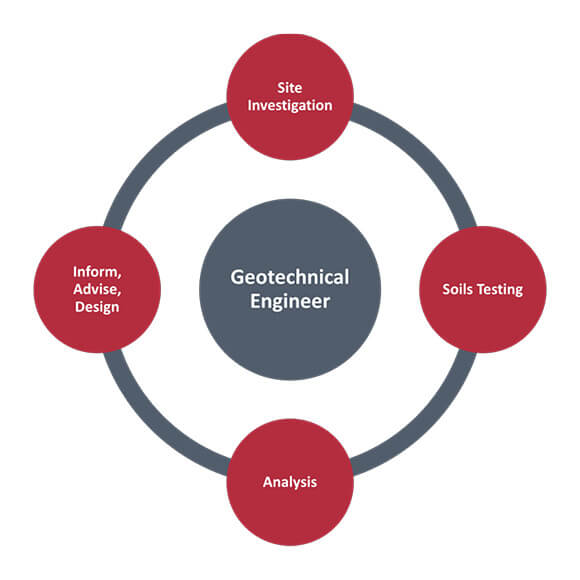The 8-Minute Rule for Geotheta
The 8-Minute Rule for Geotheta
Blog Article
The Geotheta Ideas
Table of ContentsThe 6-Minute Rule for GeothetaUnknown Facts About GeothetaIndicators on Geotheta You Should Know3 Simple Techniques For GeothetaThe 7-Second Trick For Geotheta

They carry out site investigations, collect samples, do research laboratory tests, and analyze information to review the viability of the ground for construction jobs - Geo Tech Engineer. Based upon their findings, geotechnical engineers offer recommendations for foundation style, slope security, retaining frameworks, and mitigation of geotechnical risks. They collaborate with other specialists, such as engineers, structural designers, and building groups, to make certain that geotechnical factors to consider are integrated into the overall project style and application
By examining the habits and properties of dirt and rock, they can identify possible geotechnical hazards such as landslides, dirt settlement, or incline instability. Their proficiency assists stop failings or crashes that might jeopardize lives and property. Here are some in-depth responsibilities and responsibilities of a geotechnical engineer: Website Investigation: Geotechnical engineers conduct website examinations to collect data on subsurface problems.
They interpret the data to comprehend the residential properties and actions of the soil and rock, including their toughness, permeability, compaction characteristics, and groundwater conditions. Geotechnical Analysis and Layout: Geotechnical designers evaluate the data gathered during website examinations to analyze the stability and viability of the site for construction projects. They perform geotechnical computations and modeling to examine elements such as birthing ability, negotiation, incline stability, lateral planet stress, and groundwater flow.
10 Simple Techniques For Geotheta
Foundation Style: Geotechnical designers play a critical function in developing foundations that can securely sustain the desired structure. They analyze the dirt conditions and lots demands to determine the proper foundation type, such as shallow foundations (e.g., grounds), deep structures (e.g (https://justpaste.it/ec966)., stacks), or specialized methods like soil improvement. They consider elements such as negotiation restrictions, bearing capacity, and soil-structure interaction to create ideal foundation layouts
They examine construction strategies, display website tasks, and perform field evaluations to validate that the layout suggestions are followed. If unanticipated geotechnical issues arise, they analyze the scenario and provide referrals for removal or changes to the design. Threat Evaluation and Reduction: Geotechnical engineers assess geotechnical dangers and risks associated with the project website, such as landslides, liquefaction, or soil disintegration.

Cooperation and Communication: Geotechnical designers work very closely with other experts associated with a project, such as architects, architectural engineers, and building groups. Effective interaction and partnership are important to integrate geotechnical factors to consider right into the total task style and building and construction process. Geotechnical designers supply technical proficiency, response queries, and make certain that geotechnical demands are fulfilled.
Geotheta Can Be Fun For Anyone
Right here are some kinds of geotechnical engineers: Foundation Engineer: Foundation engineers concentrate on making and evaluating structures for frameworks. They analyze the soil problems, lots demands, and website attributes to determine the most suitable foundation kind and design, such as superficial structures, deep foundations, or specialized strategies like pile foundations.
They evaluate the factors influencing incline stability, such as soil buildings, groundwater conditions, and slope geometry, and develop strategies to avoid slope failures and minimize dangers. Quake Designer: Quake designers concentrate on analyzing and designing structures to withstand seismic forces. They examine the seismic danger of a site, review dirt liquefaction capacity, and develop seismic layout requirements to make sure the security and durability of frameworks throughout quakes.
They execute area testing, gather samples, and assess the gathered data to characterize the soil buildings, geologic formations, and groundwater problems at a site. Geotechnical Instrumentation Engineer: Geotechnical instrumentation designers concentrate on tracking and gauging the habits of soil, rock, and structures. They check my reference install and keep instrumentation systems that monitor variables such as dirt negotiation, groundwater levels, incline movements, and structural variations to examine performance and provide very early warnings of possible issues.
Geotheta Things To Know Before You Get This
They perform tests such as triaxial examinations, combination tests, direct shear examinations, and leaks in the structure tests to gather data for geotechnical analysis and layout. Geosynthetics Engineer: Geosynthetics designers concentrate on the design and application of geosynthetic products, such as geotextiles, geogrids, and geomembranes. They use these products to improve soil stability, reinforce slopes, give drainage options, and control disintegration.
They have a tendency to be investigatory individuals, which implies they're intellectual, reflective, and inquisitive. They are curious, methodical, sensible, analytical, and logical. A few of them are likewise social, meaning they're kind, generous, cooperative, client, caring, handy, empathetic, skillful, and friendly. Does this noise like you? Take our totally free career test to figure out if geotechnical engineer is among your top profession suits.
In the office environment, geotechnical designers use specialized software program devices to execute estimations, develop layouts, and analyze information. They prepare records, testimonial task requirements, interact with clients and employee, and coordinate task tasks. The office setting provides a conducive setting for research study, evaluation, and cooperation with various other professionals involved in the project.
Geotheta Fundamentals Explained
They frequently visit job sites to conduct site investigations, examine geotechnical conditions, and collect information for evaluation. These visits include traveling to various places, often in remote or difficult surfaces. Geotechnical designers might do dirt sampling, conduct tests, and screen construction tasks to guarantee that the geotechnical facets of the task are being applied properly.
Geotechnical engineers additionally operate in specialized geotechnical laboratories. In these centers, they carry out experiments, perform examinations on soil and rock examples, and evaluate the engineering properties of the products. Geotechnical lab engineers work extensively in these atmospheres, managing screening tools, running instruments, and videotaping information. They team up with other lab staff to make sure precise and trustworthy testing results.
Report this page